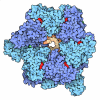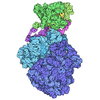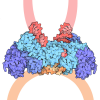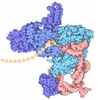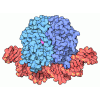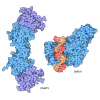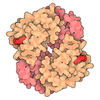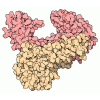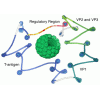+ Open data
Open data
- Basic information
Basic information
| Entry | Database: PDB / ID: 8zjr | ||||||
|---|---|---|---|---|---|---|---|
| Title | Structure of nucleosome-bound RFX5 complex | ||||||
 Components Components |
| ||||||
 Keywords Keywords | STRUCTURAL PROTEIN/DNA / Nucleosome / histone / DNA / STRUCTURAL PROTEIN-DNA complex | ||||||
| Function / homology |  Function and homology information Function and homology informationpositive regulation of MHC class II biosynthetic process / negative regulation of megakaryocyte differentiation / protein localization to CENP-A containing chromatin / Chromatin modifying enzymes / Replacement of protamines by nucleosomes in the male pronucleus / CENP-A containing nucleosome / Packaging Of Telomere Ends / Recognition and association of DNA glycosylase with site containing an affected purine / Cleavage of the damaged purine / Deposition of new CENPA-containing nucleosomes at the centromere ...positive regulation of MHC class II biosynthetic process / negative regulation of megakaryocyte differentiation / protein localization to CENP-A containing chromatin / Chromatin modifying enzymes / Replacement of protamines by nucleosomes in the male pronucleus / CENP-A containing nucleosome / Packaging Of Telomere Ends / Recognition and association of DNA glycosylase with site containing an affected purine / Cleavage of the damaged purine / Deposition of new CENPA-containing nucleosomes at the centromere / Recognition and association of DNA glycosylase with site containing an affected pyrimidine / Cleavage of the damaged pyrimidine / telomere organization / Interleukin-7 signaling / RNA Polymerase I Promoter Opening / Inhibition of DNA recombination at telomere / Meiotic synapsis / Assembly of the ORC complex at the origin of replication / SUMOylation of chromatin organization proteins / Regulation of endogenous retroelements by the Human Silencing Hub (HUSH) complex / DNA methylation / Condensation of Prophase Chromosomes / Chromatin modifications during the maternal to zygotic transition (MZT) / SIRT1 negatively regulates rRNA expression / HCMV Late Events / innate immune response in mucosa / ERCC6 (CSB) and EHMT2 (G9a) positively regulate rRNA expression / transcription coregulator binding / PRC2 methylates histones and DNA / Regulation of endogenous retroelements by KRAB-ZFP proteins / Defective pyroptosis / RNA polymerase II transcription regulatory region sequence-specific DNA binding / HDACs deacetylate histones / Regulation of endogenous retroelements by Piwi-interacting RNAs (piRNAs) / Nonhomologous End-Joining (NHEJ) / RNA Polymerase I Promoter Escape / Transcriptional regulation by small RNAs / Formation of the beta-catenin:TCF transactivating complex / Activated PKN1 stimulates transcription of AR (androgen receptor) regulated genes KLK2 and KLK3 / RUNX1 regulates genes involved in megakaryocyte differentiation and platelet function / HDMs demethylate histones / G2/M DNA damage checkpoint / NoRC negatively regulates rRNA expression / B-WICH complex positively regulates rRNA expression / DNA Damage/Telomere Stress Induced Senescence / PKMTs methylate histone lysines / Meiotic recombination / Pre-NOTCH Transcription and Translation / RNA polymerase II transcription regulator complex / Metalloprotease DUBs / RMTs methylate histone arginines / Activation of anterior HOX genes in hindbrain development during early embryogenesis / Transcriptional regulation of granulopoiesis / HCMV Early Events / sequence-specific double-stranded DNA binding / antimicrobial humoral immune response mediated by antimicrobial peptide / structural constituent of chromatin / UCH proteinases / antibacterial humoral response / nucleosome / heterochromatin formation / nucleosome assembly / E3 ubiquitin ligases ubiquitinate target proteins / Recruitment and ATM-mediated phosphorylation of repair and signaling proteins at DNA double strand breaks / HATs acetylate histones / RUNX1 regulates transcription of genes involved in differentiation of HSCs / Factors involved in megakaryocyte development and platelet production / MLL4 and MLL3 complexes regulate expression of PPARG target genes in adipogenesis and hepatic steatosis / Processing of DNA double-strand break ends / chromatin organization / Senescence-Associated Secretory Phenotype (SASP) / DNA-binding transcription activator activity, RNA polymerase II-specific / Oxidative Stress Induced Senescence / defense response to Gram-negative bacterium / killing of cells of another organism / gene expression / Estrogen-dependent gene expression / sequence-specific DNA binding / DNA-binding transcription factor activity, RNA polymerase II-specific / chromosome, telomeric region / defense response to Gram-positive bacterium / Ub-specific processing proteases / RNA polymerase II cis-regulatory region sequence-specific DNA binding / Amyloid fiber formation / protein heterodimerization activity / negative regulation of cell population proliferation / intracellular membrane-bounded organelle / chromatin binding / regulation of transcription by RNA polymerase II / chromatin / negative regulation of transcription by RNA polymerase II / positive regulation of transcription by RNA polymerase II / protein-containing complex / extracellular space / DNA binding / RNA binding / extracellular exosome / extracellular region / nucleoplasm / nucleus Similarity search - Function | ||||||
| Biological species |  Homo sapiens (human) Homo sapiens (human)synthetic construct (others) | ||||||
| Method | ELECTRON MICROSCOPY / single particle reconstruction / cryo EM / Resolution: 3.3 Å | ||||||
 Authors Authors | Xu, K. / Zhang, Y. / Yin, Y. / Xue, W. / Han, Y. / Tian, Y. | ||||||
| Funding support |  China, 1items China, 1items
| ||||||
 Citation Citation |  Journal: Nucleic Acids Res / Year: 2025 Journal: Nucleic Acids Res / Year: 2025Title: Structural basis of nucleosome binding and destabilization by the extended DNA binding domain of RFX5. Authors: Wanqiang Xue / Yaoyao Han / Ying Tian / Junzheng Wang / Zhiyuan Xie / Xin Zheng / Xue Yue / Siqi Dong / Huimin Li / Zhen Luo / Siqiu Zhang / Ying Yang / Zhe Zou / Wei Li / Nana Ma / Fangjie ...Authors: Wanqiang Xue / Yaoyao Han / Ying Tian / Junzheng Wang / Zhiyuan Xie / Xin Zheng / Xue Yue / Siqi Dong / Huimin Li / Zhen Luo / Siqiu Zhang / Ying Yang / Zhe Zou / Wei Li / Nana Ma / Fangjie Zhu / Chunlai Chen / Yimeng Yin / Yixiao Zhang / Ke Xu /  Abstract: Among the regulatory factor X (RFX) transcription factor family, RFX5 is uniquely reported to bind nucleosomes and induce nucleosome remodeling in vivo. Dysfunctions in RFX5 have been implicated in ...Among the regulatory factor X (RFX) transcription factor family, RFX5 is uniquely reported to bind nucleosomes and induce nucleosome remodeling in vivo. Dysfunctions in RFX5 have been implicated in various diseases. Here, we present the cryogenic electron microscopy (cryo-EM) structure of the RFX5-nucleosome complex, revealing that the extended DNA binding domain (eDBD) of RFX5 binds to the nucleosome at superhelical location +2. RFX5 eDBD engages not only with nucleosomal DNA but also with histones through extensive interactions. Compared to the structure of a free nucleosome, RFX5 eDBD induces localized distortion of the bound DNA gyre and detachment of the adjacent DNA gyre in the RFX5-nucleosome complex. This structural alteration could potentially increase DNA accessibility and enhance transcriptional activity in vivo. Overall, our study provides novel insights into the mechanisms by which RFX5 eDBD interacts with and destabilizes nucleosomes. | ||||||
| History |
|
- Structure visualization
Structure visualization
| Structure viewer | Molecule:  Molmil Molmil Jmol/JSmol Jmol/JSmol |
|---|
- Downloads & links
Downloads & links
- Download
Download
| PDBx/mmCIF format |  8zjr.cif.gz 8zjr.cif.gz | 323.5 KB | Display |  PDBx/mmCIF format PDBx/mmCIF format |
|---|---|---|---|---|
| PDB format |  pdb8zjr.ent.gz pdb8zjr.ent.gz | 246.4 KB | Display |  PDB format PDB format |
| PDBx/mmJSON format |  8zjr.json.gz 8zjr.json.gz | Tree view |  PDBx/mmJSON format PDBx/mmJSON format | |
| Others |  Other downloads Other downloads |
-Validation report
| Summary document |  8zjr_validation.pdf.gz 8zjr_validation.pdf.gz | 1.3 MB | Display |  wwPDB validaton report wwPDB validaton report |
|---|---|---|---|---|
| Full document |  8zjr_full_validation.pdf.gz 8zjr_full_validation.pdf.gz | 1.3 MB | Display | |
| Data in XML |  8zjr_validation.xml.gz 8zjr_validation.xml.gz | 39.5 KB | Display | |
| Data in CIF |  8zjr_validation.cif.gz 8zjr_validation.cif.gz | 60 KB | Display | |
| Arichive directory |  https://data.pdbj.org/pub/pdb/validation_reports/zj/8zjr https://data.pdbj.org/pub/pdb/validation_reports/zj/8zjr ftp://data.pdbj.org/pub/pdb/validation_reports/zj/8zjr ftp://data.pdbj.org/pub/pdb/validation_reports/zj/8zjr | HTTPS FTP |
-Related structure data
| Related structure data |  60154MC  8zjtC M: map data used to model this data C: citing same article ( |
|---|---|
| Similar structure data | Similarity search - Function & homology  F&H Search F&H Search |
- Links
Links
- Assembly
Assembly
| Deposited unit | 
|
|---|---|
| 1 |
|
- Components
Components
-Protein , 5 types, 9 molecules AEBFCGDHM
| #1: Protein | Mass: 15543.203 Da / Num. of mol.: 2 Source method: isolated from a genetically manipulated source Source: (gene. exp.)  Homo sapiens (human) Homo sapiens (human)Gene: H3C15, HIST2H3A, H3C14, H3F2, H3FM, HIST2H3C, H3C13, HIST2H3D Production host:  #2: Protein | Mass: 11824.946 Da / Num. of mol.: 2 Source method: isolated from a genetically manipulated source Source: (gene. exp.)  Homo sapiens (human) Homo sapiens (human)Gene: H4C1, H4/A, H4FA, HIST1H4A, H4C2, H4/I, H4FI, HIST1H4B, H4C3, H4/G, H4FG, HIST1H4C, H4C4, H4/B, H4FB, HIST1H4D, H4C5, H4/J, H4FJ, HIST1H4E, H4C6, H4/C, H4FC, HIST1H4F, H4C8, H4/H, H4FH, ...Gene: H4C1, H4/A, H4FA, HIST1H4A, H4C2, H4/I, H4FI, HIST1H4B, H4C3, H4/G, H4FG, HIST1H4C, H4C4, H4/B, H4FB, HIST1H4D, H4C5, H4/J, H4FJ, HIST1H4E, H4C6, H4/C, H4FC, HIST1H4F, H4C8, H4/H, H4FH, HIST1H4H, H4C9, H4/M, H4FM, HIST1H4I, H4C11, H4/E, H4FE, HIST1H4J, H4C12, H4/D, H4FD, HIST1H4K, H4C13, H4/K, H4FK, HIST1H4L, H4C14, H4/N, H4F2, H4FN, HIST2H4, HIST2H4A, H4C15, H4/O, H4FO, HIST2H4B, H4C16, H4-16, HIST4H4 Production host:  #3: Protein | Mass: 14319.716 Da / Num. of mol.: 2 Source method: isolated from a genetically manipulated source Source: (gene. exp.)  Homo sapiens (human) / Gene: H2AC4, H2AFM, HIST1H2AB, H2AC8, H2AFA, HIST1H2AE / Production host: Homo sapiens (human) / Gene: H2AC4, H2AFM, HIST1H2AB, H2AC8, H2AFA, HIST1H2AE / Production host:  #4: Protein | Mass: 14351.734 Da / Num. of mol.: 2 Source method: isolated from a genetically manipulated source Source: (gene. exp.)  Homo sapiens (human) / Gene: H2BC12, H2BFT, HIRIP1, HIST1H2BK / Production host: Homo sapiens (human) / Gene: H2BC12, H2BFT, HIRIP1, HIST1H2BK / Production host:  #7: Protein | | Mass: 16992.186 Da / Num. of mol.: 1 Source method: isolated from a genetically manipulated source Source: (gene. exp.)  Homo sapiens (human) / Gene: RFX5 / Production host: Homo sapiens (human) / Gene: RFX5 / Production host:  |
|---|
-DNA chain , 2 types, 2 molecules IJ
| #5: DNA chain | Mass: 45664.109 Da / Num. of mol.: 1 Source method: isolated from a genetically manipulated source Source: (gene. exp.) synthetic construct (others) / Production host:  |
|---|---|
| #6: DNA chain | Mass: 45081.770 Da / Num. of mol.: 1 Source method: isolated from a genetically manipulated source Source: (gene. exp.) synthetic construct (others) / Production host:  |
-Details
| Has protein modification | N |
|---|
-Experimental details
-Experiment
| Experiment | Method: ELECTRON MICROSCOPY |
|---|---|
| EM experiment | Aggregation state: PARTICLE / 3D reconstruction method: single particle reconstruction |
- Sample preparation
Sample preparation
| Component | Name: free nucleosome / Type: COMPLEX / Entity ID: #1-#4 / Source: RECOMBINANT |
|---|---|
| Source (natural) | Organism:  Homo sapiens (human) Homo sapiens (human) |
| Source (recombinant) | Organism:  |
| Buffer solution | pH: 8 |
| Specimen | Embedding applied: NO / Shadowing applied: NO / Staining applied: NO / Vitrification applied: YES |
| Vitrification | Cryogen name: ETHANE |
- Electron microscopy imaging
Electron microscopy imaging
| Experimental equipment |  Model: Titan Krios / Image courtesy: FEI Company |
|---|---|
| Microscopy | Model: FEI TITAN KRIOS |
| Electron gun | Electron source:  FIELD EMISSION GUN / Accelerating voltage: 300 kV / Illumination mode: FLOOD BEAM FIELD EMISSION GUN / Accelerating voltage: 300 kV / Illumination mode: FLOOD BEAM |
| Electron lens | Mode: BRIGHT FIELD / Nominal defocus max: 2400 nm / Nominal defocus min: 1400 nm |
| Image recording | Electron dose: 49.41 e/Å2 / Film or detector model: GATAN K3 (6k x 4k) |
- Processing
Processing
| EM software | Name: PHENIX / Category: model refinement | ||||||||||||||||||||||||
|---|---|---|---|---|---|---|---|---|---|---|---|---|---|---|---|---|---|---|---|---|---|---|---|---|---|
| CTF correction | Type: PHASE FLIPPING AND AMPLITUDE CORRECTION | ||||||||||||||||||||||||
| 3D reconstruction | Resolution: 3.3 Å / Resolution method: FSC 0.143 CUT-OFF / Num. of particles: 167866 / Symmetry type: POINT | ||||||||||||||||||||||||
| Refine LS restraints |
|
 Movie
Movie Controller
Controller




 PDBj
PDBj

